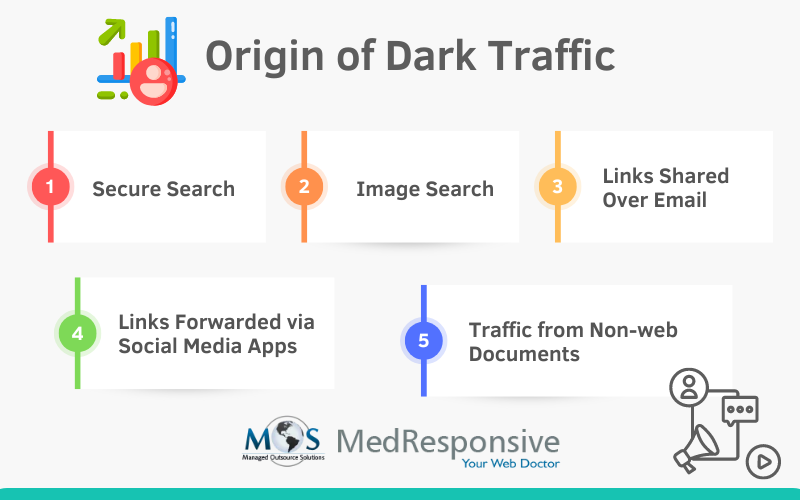Whether you are a blogger, a digital marketing expert or a business owner, you rely on website metrics to determine visitor engagement, which campaigns are successful, and the source of website traffic. One of the tools you utilize for this purpose would be Google Analytics that provides you with web statistics and data. You can use this information for devising future strategies, tactics to drive business growth.
However, are you sure that you’re not missing out on anything? Hidden underneath the layers of analytics data, an issue known as Dark traffic is the black hole of SEO that you may not be aware of as it is mis-categorized as direct traffic on the Google Analytics Dashboard. This could potentially skew the impact of your marketing efforts as the data is not entirely accurate.
Ever since 2012, Google has not allowed Analytics users to see the keywords that users typed-in to search engines and is instead listed as “not provided”. This move was made considering the privacy of signed- in users but it ended up being a loss of valuable information to business owners and Google Analytics users. Another change that affected dark traffic is when Google restricted access to Keyword Planning Tool to those with at least one active AdWords campaign.
So when a large portion of users are misdirected, it may even significantly affect the quality of your success. Partnering with SEO consulting services can help you reduce the effect of dark traffic and maximize the revenue of your business.
What Is Dark Traffic?
To comprehend dark traffic accurately, you need to know what constitutes direct traffic. The total site traffic is divided into direct, search and paid visitors, based on the source of their origin. Direct traffic is essentially the number of visitors who arrived at your website by typing the URL directly into the search bar or using bookmarks. The ideal range of direct referral should be from 10% to 20% of the whole traffic and if it’s less than that, the website’s reach is considered too poor and if the incoming traffic is higher, then the website is said to have a lot of dark traffic.
The data in direct traffic doesn’t always consist of users who directly came to the website by manually typing the address or through bookmarking. The root of the issue comes down to when attribution or referral information of the visitor’s origin cannot be tracked; Google sorts it into direct traffic instead. In fact, whenever Google can’t identify how a user reached the website, it automatically assumes it as direct traffic.
When a user who is logged into Google types queries onto the search engine, the keywords he/she uses are what determines the web pages they land on. These keywords, however are hidden from Google Analytics users as they are grouped under “not provided,’ so the keywords of a search are not available anymore. This is specifically known as “dark search” and it’s a problem for SEO specialists and marketers since it makes keyword research and measuring the ROI of specific keywords much more challenging.
The trouble with dark traffic is that it can cause setbacks for a company since it is vital to understand the referral journeys of the visitors, in order to analyze and discover their most valuable customers. This issue is also amplified on mobile because of its socially-driven nature in which link-clicking from apps installed is the norm to arrive at a website.
Where Does Dark Traffic Come from?
Dark traffic may arise from various sources, such as the following:
- When a visitor clicks a link from a secure HTTPS connection to land on an insecure HTTPS website, referral information is lost and therefore it is categorized as dark traffic
- Links shared and clicked over social media apps especially when they offer end-to-end encryption and does not pass referral information
- Links send out through emails or text messages for purposes of digital marketing that don’t have source data
- Any link that originates from non-web based files such as PDF or WORD document.
The Impact of Dark Traffic
The concerns with dark traffic lie on the shoulders of digital marketers mainly because it obstructs the traffic credit given to the right channels as they are misdirected, leaving you in the dark about the performance of the digital campaigns. You require accurate information about website analytics to understand and evaluate the results of your marketing efforts and for devising further strategies, so the presence of dark traffic could potentially misguide the time and resources you spend on marketing campaigns.
Let’s say you come up with and design an innovative email marketing strategy, work tirelessly to execute it and when the results arrive, you saw the sales increase but no data about the outcome of your email marketing. You may feel discouraged and abandon email marketing for the next project thinking of it as a failed strategy, though it might have been the reason you saw increase in sales.
So, if you are inadvertently led to bad strategic decisions formed from dark traffic, you might miss out on valuable data that drive substantial amount of traffic and thereby will be left with a missed opportunity for revenue growth. On a brighter note, dark traffic is identifiable and controllable to an extent so you don’t have to deal with the misfortune of uncertainty when it comes to your direct traffic.
How to Resolve Dark Traffic?
While it might be impossible to completely get rid of dark traffic, there are still ways to come around it so you can prevent it from occurring as much as possible going forward by:
- UTM parameters
The tried and tested method to gain control of dark traffic is by implementing UTM parameters. Google UTM parameters are tags appended manually at the end of each URL in hyperlinks to track relevant information about the link. The types of UTM parameters you can employ are:
- Campaign source (utm_source) – This tag identifies and shows you the source of the visit, for example – utm_source=Google means source of traffic is Google Search.
- Campaign medium (utm_medium) – This code is used to identify the specific medium or channel your visitor found the URL in. Examples are social media, emails and CPC ads. The tag is utm_medium=social.
- Campaign name (utm_campaign) – The name given to the URL for indicating which campaign the promotion is associated with.
- Campaign term (utm_term) – The parameter to identify the paid keywords driving the campaign.
Campaign content (utm_content) – This tag is used to identify the exact item on your page that was clicked. For example, if you have two CTAs, it helps to distinguish between the two.
You can use a UTM link builder for this purpose by filling out a form and letting the software build a link for you.
- Use Google Analytics
Another way to identify dark traffic is by implementing a new segment in Google Analytics to locate only direct traffic. Apply the segment and identify the potential pages on your website that is likely to gain a lot of direct traffic such as the home page of your site. The goal is to filter out pages that are easy and popular to find so that only pages with longer, complex URLs remain which are least likely to gain direct traffic. Your website is most likely to have a mix of direct and dark traffic, but if a page is getting a massive amount of direct traffic, chances are the majority of it is dark traffic.
Other ways to find dark traffic include incorporating surveys or forms to directly inquire about the source of visit from users, easy sharing options for applications such as Messenger or Whatsapp, and excluding return visitors from your website. You can use pre-built methods that are available to add and customize new segment to your liking.
- Filter out to reclassify traffic
While your team is working on your website, they might visit it on a regular basis so make sure to exclude them from your traffic. You can do that by finding and adding the I.P address of office location and block Google Analytics from tracking this I.P. Google Analytics has a data called channels in the report workspace that you can utilize to understand the source traffic. The channel has default groupings such as direct, email, referral and display and the option to create customized channel to categorize traffic to your website.
You may also reclassify traffic into channels such as social media traffic, so if the user found the link from Facebook, it will be classified under social media channel. Filtering out this way helps you to sort data and gain a broad overview of the source of traffic to your website.
The complexity of the internet ecosystem makes it impossible to entirely remove dark traffic but you can mitigate its effect to some extent by improving data tracking and collection accuracy. This ensures that you make smart marketing strategies and understand any potential user-behavior changes that may affect the revenue of your business. Creating and navigating intricate customized reports on Google Analytics can be tricky, so hiring a search engine optimization company will take this responsibility off your hands. Search engine experts can plan and implement the best digital marketing strategies to help your business grow.





